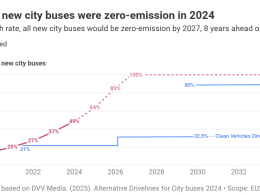More than 40% of the world’s electricity in 2024 was generated from non-fossil fuel sources, according to a new report by global energy think tank Ember. However, the report also reveals that global carbon dioxide (CO₂) emissions reached an all-time high, driven by a surge in electricity demand linked to unusually hot weather.
Despite the significant progress in renewable energy deployment, fossil fuel use rose slightly last year, as heatwaves led to higher consumption of electricity—particularly for air conditioning—requiring additional output from coal and gas power stations.
Phil Macdonald, Managing Director of Ember, commented: “Solar power has become the engine of the global energy transition. Amid the noise, it’s essential to focus on the real signal. Hotter weather drove the fossil generation increase in 2024, but we’re very unlikely to see a similar jump in 2025.”
Solar power remains the fastest-growing source of electricity globally. Over the past three years, solar output has doubled, and it has now maintained its position as the world’s most rapidly expanding power source for the twentieth consecutive year. While it contributes just under 7% to global electricity—roughly equivalent to the annual power demand of India—its growth has been dramatic.
China led the global expansion, accounting for over half of the total increase in solar capacity. India also saw significant growth, with its solar capacity doubling between 2023 and 2024.
Wind energy now provides just over 8% of the world’s electricity, while hydropower remains the largest source of clean energy at 14%. Nuclear energy accounts for around 9%. Both hydro and nuclear are expanding at a much slower pace than solar and wind.
The report notes that clean electricity’s share of global generation—40.9%—has reached its highest level since the 1940s. At that time, electricity demand was far lower, and hydropower provided a major portion of supply.
However, the rising demand for electricity, which increased by 4% in 2024, continues to outstrip the growth of renewables. As a result, CO₂ emissions from the power sector increased by 1.4% to a record 14.6 billion tonnes.
This spike is largely attributed to greater fossil fuel use in fast-growing economies such as China and India, where energy demand continues to rise rapidly. Coal accounted for 34% of global electricity generation, while gas contributed 22%.
In a separate report, the EU’s Copernicus Climate Change Service noted that March 2025 was the second warmest on record, extending an unprecedented run of global temperature highs.
Ember has long predicted a turning point where emissions from electricity would begin to decline. However, that tipping point has yet to arrive, as growth in clean energy has not kept pace with surging global demand.





















